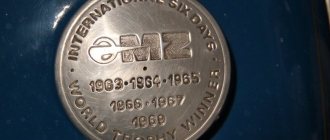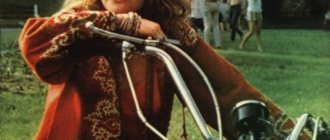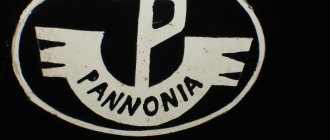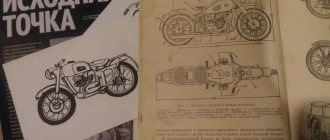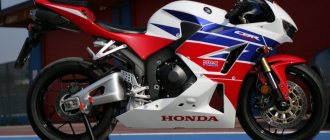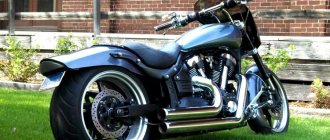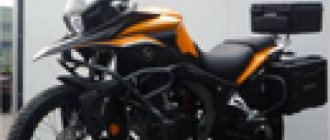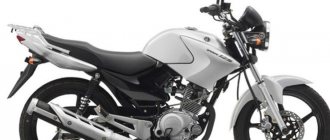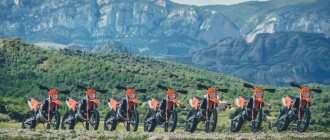Izhevsky IZH
This plant was created for the production of weapons. Nevertheless, motorcycles were produced here from 1929 to 2008, which gained popularity among residents of the entire USSR. Models “Jupiter” and “Planet” were reliable assistants for Soviet citizens.
Villagers moved on such vehicles with strollers, carrying vital cargo. In 1973, the Izhevsk plant released the sports model IZH Planet Sport. This two-wheeled horse was “licked” from Japanese and German prototypes of those times.
Its engine power was 22 horsepower. In addition, unlike ordinary copies, this model was of fairly high quality. That is why it was actively sold in Finland, Great Britain, and the Netherlands.
Two-wheeled and three-wheeled vehicles were distinguished by their unpretentiousness, reliability, and high maintainability. Their production began in 1951.
At the same time, the designers took the German motorcycle DKW NZ 350 as a basis.
Throughout its history, IZH's priority has been the production of weapons. Now motorcycles are produced in very small batches.
The first IZH motorcycles: how the legendary Soviet motorcycle brand was born
You rarely see the legendary IZH motorcycle on the streets today. But 20 years ago, two-wheeled and three-wheeled horses from Izhevsk were quite common. During the era of the Soviet Union, IZH motorcycles surpassed the famous Ural in popularity; they were cheaper and easier to buy.
In 1929, at Izhstalzavod, a group of engineers under the leadership of P.V. Mozharov began work on creating a motorcycle to participate in the All-Union Motorcycle Rally. The interest and desire of the developers is so great that in just a few months they have assembled 5 different prototypes of motorcycles, from the powerful and brutal IZH-1 to the more compact but passable IZH-5. Let's take a closer look at the IZH-1 motorcycle; after all, it was the first.
The heavy bike was created using innovative technologies of its era. At that time, it could easily be called one of the most advanced motorcycles in the world. Powerful (1.2 liters, 24 hp) four-stroke two-cylinder V-type engine, 3-speed gearbox, engine crankshaft located longitudinally. Maximum speed 65 km/h. Motorcycles IZH-1 and IZH-2 differed slightly from each other. These heavy bikes were easy to ride. The IZH-1 had a drawback: it coped extremely poorly even with light off-road conditions; this problem was solved on the IZH-2.
IZH-3 was equipped with a two-cylinder V-shaped 750 cc power unit. IZH-4 and IZH-5 were light motorcycles, with a smaller engine capacity, but very nimble and maneuverable.
All 5 models successfully covered the motorcycle rally route, which was more than 3 thousand km long. However, the government approved only one of them for production - IZH-4. Later this project was pushed back. The USSR government did not consider it necessary to organize technical races with world motorcycle manufacturers and compete with them. The engineers were required to create the most simple, cheap motorcycle possible, in order to later launch it into series. Money was simply not given for more complex projects.
Of course, from a technological point of view this was a serious mistake. The country and domestic motorcycles have artificially fallen behind the global motorcycle industry. But the orders of the party were not discussed; engineers implemented the demands of officials by developing the IZH-7 model in 1933.
Motorcycle IZH-7
It was the IZH-7 that became the first production motorcycle of the Izhevsk plant. It underwent a “labor reduction” operation, the front guards disappeared, small round ones were installed instead of comfortable large flat footpegs, the rotating throttle was replaced by a rotary coin, and many more changes that significantly reduced driving comfort and negatively affected the characteristics of the motorcycle. IZH-7 was equipped with a single-cylinder, two-stroke, air-cooled engine with a volume of 293 cc and a power of 5.5 liters. With. The maximum speed is 80 km/h, fuel consumption is 6–7 litres/100 km with a fuel tank capacity of 12 liters.
The IZH-7 motorcycle was produced for 4 years. He managed to take part in 8 motorcycle races and competitions. A total of 5,779 motorcycles were produced. The price of IZH-7 was 3360 rubles. In 1938, it will be replaced by the next generation of motorcycles - IZH-8.
Kyiv "Dnepr"
A heavy motorcycle with a sidecar, which was produced by the Kyiv Motorcycle Plant (KMZ), gained enormous popularity among residents of the vast Soviet Union. The drive wheel on the stroller made it possible to overcome any off-road conditions. The MT-9 was produced with an automatic clutch release and ignition advance system.
The MT-9 model was already produced with reverse gear. The MT-10 received a 12-volt electrical system and a larger fuel tank.
The most advanced technically was the MT-11 model, which received a four-stroke engine with 32 horsepower and a 4-speed gearbox.
Here the parking brake, the drive wheel of the stroller, and the reverse speed were used. The carrying capacity of the device was 260 kilograms, so this “iron horse” was a real helper in the household. The MT-16 model was also released with all-wheel drive.
The KMZ enterprise was founded in 1945. The last bikes rolled off the plant's assembly line in 2008. Already in 2021, literally all equipment was removed from the plant.
Irbitsky "Ural"
The Ural motorcycle production enterprise was founded back in 1941. Before this, engineers purchased 5 BMW bikes from Sweden, disassembled them down to the screw, studied the technology of processing parts and began their own production. During World War II, motorcycles began to be produced in the Urals. In addition, separate production areas were located at the trailer plant.
Over the years of its existence until the 90s, millions of motorcycles with sidecars were produced, which were distinguished by their endurance, reliability and unpretentiousness. Small batches of products are produced to this day (even after the crisis of the 90s).
"Minsk"
MMVZ was founded back in 1945. In 1951, serial production of the Minsk motorcycle began. Now the plant specializes in the production of sports and road equipment. It was privatized in 2007.
The Minsk bike is a lightweight road unit that is easy and pleasant to operate. The first model of the enterprise was a motorcycle built on the basis of the German DKW RT125. It was so successful that it was released in 7 countries around the world.
Production began on the basis of equipment and technical documentation from a German plant, which was dismantled in the Soviet occupation zone.
Motorcycles of this brand were equipped with a 125 cc engine. They were distinguished by practicality, endurance, and high maintainability.
Bicycles “Orlyonok”, “Lastochka”, “Minsk” were also produced here.
The company broke up into several small ones and went bankrupt in 2018. Motovelozavod LLC still produces KRAKKEN bicycles.
Buy in the online store, best prices, inexpensive delivery
September 2009 marked 80 years since the first IZH motorcycle was released. The history of motorcycle production in Izhevsk is inextricably linked with the name of Pyotr Vladimirovich Mazharov. He was an avid motorcyclist and a talented engineer. It was he who actually organized the mass production of motorcycles in the Soviet Union.
P.V. Mazharov was born on September 7, 1888. His ability to work with his hands and his powerful talent as a designer were evident even before the revolution. He repaired boats and cars, and in 1914 he even managed to restore a three-seater airplane, which he later flew over the outskirts of Tambov, where his father’s estate was located.
But his true passion was motorcycles. Since 1924, Mazharov worked in Izhevsk. There they remembered for a very long time how every day he flew with a deafening crash from the barracks in which he lived to work and returned back in the evening. He had a German motorcycle, the only one in the city at that time. This passion was passed on to all residents of Izhevsk.
In the spring of 1928, Mazharov submitted an official proposal to management that it was necessary to organize the production of motorcycles at Izhstalzavod. First design bureau. which began to develop motorcycles was created in the same year at Izhstalzavod Izhevsk. Mazharov himself became its first leader. The first motorcycles were developed, manufactured and tested under his leadership.
The first motorcycle "IZH-1" was released on September 17, 1929. It was a beauty weighing 300 kg, with a cardan transmission that was progressive at the time and a stamped frame. This model was the most important for the plant. The next modified model, which had a sidecar wheel drive and forced engine cooling, was called IZH-2. The very first motorcycle on which the Wanderer engine was installed was designated “IZH-3”. Those who study the history of technology believe that the first Izhevsk motorcycle was created on September 17, 1929. But this is not true. IZH-1 was manufactured after IZH-3, which was made and tested in the spring of that year.
The year 1929 saw the greatest flowering of Mazharov’s talent. In just 8 months, he managed to develop 5 models of motorcycles with a complete layout and create a sketch of the sixth model. The well-known generation of “Izh” came into being - “Izh-1”, “Izh-2”, “Izh-3”, “Izh-4”, which was the best of all models Izh, “Izh-5”, “L” -300", "Tremass-300", "NATI-A-750".
In 1932, a special commission was created under the People's Commissariat of Heavy Industry to deal with the problems of motorcycle production. She decided to organize the Izhevsk Motorcycle Plant on the basis of the experimental workshops of Izhstalzavod, where the first models IZH-2 and IZH-2 were manufactured. Already in 1933, the IZH-7 motorcycle began to be manufactured at this plant. This was a variant of the L-300, improved and modified by Mazharov. Some of these motorcycles have survived to this day. After this, Mazharov continued to work on Soviet motorcycles in Moscow and Leningrad. He also had a chance to visit abroad
In 1934 P.V. Mazharov died.
Motorcycles began to be produced en masse at the machine-building plant in Izhevsk in 1946. Already in 1945, immediately after the war ended, a design group was created there again. Soon, technical documentation and drawings of the DKV "NTs-350" motorcycle were brought to the plant from Germany. Having changed almost nothing in the design of the motorcycle, the plant immediately began producing a copy of it, called IZH-450. After a thorough modernization of the motorcycle was carried out, it received the name IZH-49. During its design, such technical innovations as a rear suspension equipped with hydraulic shock absorbers, a telescope-type front fork and much more were used. This made it possible to obtain a very easy-to-use and comfortable motorcycle.
Soon the small city of Izhevsk became literally the capital of motorcycle production. At the end of the 70s, up to 350,000 motorcycles were produced there per year. Izhevsk motorcycles were distinguished by good maneuverability on bad roads. They have become very popular among the population of the country. Somewhat later, the production of sports motorcycles began, which were intended for both cross-country competitions and road racing. But IZh motorcycles received real recognition when the famous family “IZH - Planet Sport”, “IZH - Planet”, “IZH - Junker” and IZH - Jupiter appeared.”
Nowadays, the world's leading manufacturers offer their products to motorcycle enthusiasts. Russian motorcycles are not very competitive in terms of design solutions and technical characteristics. But people still love these motorcycles. They are relatively inexpensive and designed quite simply. In addition, it is easy to find the necessary spare parts and components for them.
Models 1929 Designer P.V. Mozharov. IZH - 1The motorcycle belongs to the class of heavy motorcycles.
The motorcycle is based on a stamped frame made of two solid trusses. The lower part of the frame also served as a muffler housing - this feature was characteristic of all five motorcycles of the first series. It was an impressive car in terms of weight and dimensions with a two-cylinder four-stroke V-twin engine with a displacement of 1200 cubic meters. cm and maximum power of 24 hp. The engine crankshaft was located longitudinally, torque was transmitted to the rear wheel from a three-speed gearbox, made in a block with the engine, and a driveshaft.
The vehicle was intended for operation with both passenger and cargo trailers. The power reserve ensured the ability to drive on the most difficult roads. IZH - 2 (modification of IZH - 1)
Intended for heavy off-road and muddy roads. Characteristic features are:
four-stroke two-cylinder V-engine with cardan drive to the rear wheel; external spinal frame made of stamped elements; the lower branches of the frame are both exhaust pipes and mufflers; rear wheel suspension is spring, lever; the rear wheel axle is rigidly fixed to the frame; manual gear shift drive to the wheel of the stroller with a bodice above the rear wheel axle.
Unlike the base model, it had forced cooling and a reinforced sidecar. The motorcycle could carry four: a driver, a passenger in the back seat, and two passengers in a sidecar. IZH - 3
To reduce the amount of development by P.V. Mozharov used a power unit from a Wanderer motorcycle in this model. The engine is a four-stroke two-cylinder V-twin with a capacity of 750 cc. see, collapsible frame made of stamped steel elements, front wheel suspension lever, parallelogram fork with a progressive spring (winding diameter increases towards the middle). The rear wheel axle is rigidly fixed to the frame. The rear wheel is driven by a bushing-roller chain. IZH - 4 Model of a light motorcycle. Single-cylinder two-stroke engine from the German company `Stock` with a displacement of 200 cc. see, cardan drive of the rear wheel, frame made of stamped elements, parallelogram fork. IZH - 5
Four-stroke engine with one vertically positioned 400 cc cylinder. see. The rear wheel drive is secured by a bushing-roller chain. The frame, gas tank, saddle and handlebars are modified parts of the Neander motorcycle. This motorcycle was the first to use a side stand instead of a wheel stand.
Models IZH - 7, IZH - 8, IZH - 9, IZH - 12
IZH - 7
Three-speed gearbox with dry multi-plate clutch, single-cylinder two-stroke
air cooled engine. The motorcycle showed good qualities and took first places in a number of competitions.
Single-seater with a single-cylinder, air-cooled, two-stroke engine. Using this machine, assembly mechanic Nikolai Peshekhonov, participating in All-Union competitions, became a champion more than once, and he was the first in Udmurtia to be awarded the title of Master of Sports of the USSR
The design of the four-stroke single-cylinder engine with double scavenging and air cooling was developed by Leningrad. Three-speed gearbox with a sliding pair of constant-mesh gears. IZH - 12
Motorcycle IZH - 49 and its modifications
Story. IZH - 49
Shock absorbers for the rear wheel suspension and a telescopic fork for the front, as well as a low landing, made this car indispensable when driving on country roads. The rear wheel suspension and telescopic fork ensured a smooth ride. At 49 the stamped frame ended its existence
Motorcycle IZH-56 and its modifications
Story. IZH - 56
Instead of a stamped frame, a welded, tubular frame was used, a double saddle gave the motorcycle a new shape, determined a new, semi-sporty driving position, the rear wheel suspension was carried out using a swinging fork and two spring-hydraulic shock absorbers, pivotally connected to the frame, the front and rear wheels are interchangeable, the chain running from the gearbox to the rear wheel was protected by a sealed casing. The engine of this motorcycle had a cylinder consisting of a finned aluminum jacket with a cast iron liner pressed into it.
IZH - 58 and its modifications
What was original in its design was the connection of two crankshafts with one flywheel located in a special chamber between the cylinders. After a full cycle of bench and road tests, the IZH-58 engine was recommended for mass production. Engine power 18 l. With. The engine was installed on a crew unit, unified with the crew of the IZH-56 motorcycle. The motorcycle was first called IZH-58, and then Izh-Jupiter. The motorcycle was produced in two modifications - both for riding alone and with a side trailer.
IZ Planet. Model history
On the basis of the IZH-56 motorcycle, its modification Izh Planet was created in 1962. The motorcycle differed from the IZH-56 in the design of the gas tank, saddle, front and rear flaps, and mufflers. Thus, the fixed seat was replaced with an easily removable one, and stamped and welded ones were used instead of stamped shields. IZH Planet - 2
Increased engine power and a different design of wheel hubs. Instead of stamped steel wheel hubs and brake pads, cast aluminum alloys were used. IZH Planet - 3
Unified crew parts with motorcycles “Izh Yu - 3” and “Izh Yu - 3K”, which differed from their predecessors in the design of the gas tank, tool boxes, mud flaps, more powerful engines with standardized gearboxes, a higher steering wheel and closer to the driver, which improved landing and control . For the first time, direction indicators were installed on IZh motorcycles. IZh Planet Sport
Designed for tourist and sports trips, both alone and with a passenger. The motorcycle met the requirements of the domestic and foreign markets in terms of technical parameters, convenience and safety, and had an attractive appearance, which was achieved due to the successful arrangement of all parts and components, the shape of the gas tank, tool boxes, saddle, and two-color painting. For the first time in the domestic motorcycle industry, a separate engine lubrication system was introduced using an automatic oil dosing device, which reduced the toxicity of exhaust gases. For the first time, the UNECE requirements for lighting technology and its functional solutions were met. Some design solutions were used on all subsequent motorcycle models. The motorcycle had high dynamic qualities - acceleration time to 100 km/h did not exceed 11 seconds, fuel consumption at a speed of 60 km/h was 3.5 liters per 100 km. This model was intended for lovers of high speeds and therefore became popular among young people. IZH Planet - 4
The motorcycle is distinguished by other external forms that meet the requirements of technical aesthetics, the design of individual engine components, electrical equipment, crew and increased safety. The IZH P-4 engine was equipped with a system that provided automatic dosing of oil, reducing its consumption by half, which reduced exhaust toxicity. An electrical equipment system was used with a three-phase 100-watt synchronous alternating current generator with a voltage of 12 volts, with a semiconductor rectifier and a non-contact semiconductor voltage regulator. The motorcycle differed from the IZH P-3 by increased front wheel travel, increased strength of the fork legs, and improved shock absorption of the rear wheel. The front deep shield was replaced with a shallow one - a circular type. Switches of a new design were installed, which ensured control of all devices without taking the driver’s hands off the steering wheel, an automobile-type ignition switch with a license key, and an anti-theft device.
IZh motorcycles are quite close to many motorcyclists from the Soviet Union. The first prototype of IZH-1 in 1929 was designed by engineer Pyotr Vladimirovich Mozharov, who practically became the founding father of the brand.
Looking at the design of the motorcycle, I can note that in those years our IZH-1 motorcycle was definitely no worse than the creations of the Americans from Harley-Davidson, although some points are very confusing. The complex and unjustified design of the IZH-1 fork could have been much simpler. The IZH-1 was a very passable motorcycle and could accelerate to decent speeds, but due to the design of the front suspension, strong vibrations and vibrations began at speeds above 60 km/h, which sharply reduced the safety and control of the motorcycle.
At the heart of the IZH-1 motorcycle is a two-cylinder, four-stroke V-shaped transverse engine with a displacement of 1200 cm3 and a power of 24 hp. Torque is transmitted to the rear wheel through a three-speed gearbox and driveshaft. Overall the design is very reliable, but at the same time heavy. The total weight of the motorcycle exceeds 300 kg.
The most interesting thing is that a similar drive design was and is used by the legendary Italian brand Moto Guzzi. Of course, everything is much more modern and perfected. But it is worth noting that IZh had incredible potential, but in the end they went in a different direction.
The release date of the first Izhevsk motorcycle “IZH-1” is clearly indicated in the factory history documents. On September 17, 1929, he rolled out of the gates of Izhstalzavod to the enthusiastic exclamations of those gathered. This unique machine, installed today in the museum of the Izhmash association, was quite progressive at that time - it had a four-stroke two-cylinder 24-horsepower engine with a displacement of 1200 cubic centimeters, a stamped frame, the rear of which was used as a muffler, and also cardan transmission, which was then considered a bold technical solution.
On their first-born, the designers used interchangeable wheels. Without a sidecar, the motorcycle weighed 300 kilograms, but it did not seem particularly bulky, since it was designed very rationally.
At the end of the 20s, the Avtodor council sent P.V. Mozharov on a business trip to foreign factories. From there he brought several German motorcycles of different brands, instruments and tools. At the same time, Avtodor purchased 14 well-proven English and American motorcycles, gave them bench tests and tested them (the then famous tester S.I. Karzinkin was involved in this matter) in the 1st All-Union Motorcycle Rally in 1928. Mozharov, who took part in it on a German Neander, pleased the riders and spectators with the words: “... a Soviet motorcycle has already been designed, suitable for riding on our roads. Now at the Izhevsk plant they have started assembling such machines, by the spring the first three prototypes will be ready, which we will probably present for the next motorcycle rally, and then Ruzhpultrest will begin their mass production." Indeed, in the fall of the same year they began to design in Izhevsk and build several experimental motorcycles. However, not everything went smoothly, and for the start of the 2nd All-Union Motor Ride, only IZH-1 was prepared (I. Shchedrin’s team of mechanics completed training on September 17, 1929), IZH-2 and IZH-3, and two more “IZH-4” and “IZH-5” were being adjusted, but they were hopelessly late for the start. So they were sent on the run untested, with unadjusted carburetors... Nevertheless, all five successfully completed the 3,300-kilometer route and finished in Moscow.” IZH-1 and IZH-2 were almost identical, equipped with four-stroke, two-cylinder, V-shaped engines with a displacement of 1200 cm3, maximum power of 24 hp. With. at 3000 rpm. Magneto ignition. The engine was located across the frame. The gearbox had three stages. Drive to the rear wheel is by cardan shaft. The wheel of the side trailer (sidecar) was also driven, so the cars walked confidently off-road; 23 liters of fuel in the gas tank was enough for 300 km, the maximum speed reached 65 km/h. The front fork is parallelogram. The motorcycle wheelbase is 1400 mm, ground clearance is 120 mm. Tire size - 4.0-27. Weight with sidecar - 300 kg. The motorcycle belongs to the class of heavy motorcycles. The motorcycle is based on a stamped frame made of two solid trusses. The lower part of the frame also served as a muffler housing - this feature was characteristic of all five motorcycles of the first series. It was an impressive car in terms of weight and dimensions with a two-cylinder four-stroke V-twin engine with a displacement of 1200 cubic meters. cm and maximum power of 24 hp. The engine crankshaft was located longitudinally, torque was transmitted to the rear wheel from a three-speed gearbox, mounted in a block with the engine and driveshaft. The machine was intended for operation with both passenger and cargo trailers. The power reserve ensured the ability to drive on the most difficult roads.
Characteristic:
Engine displacement is 1200 cm3. Number of power strokes – 4. Number of cylinders – 2. Number of gears – 3. Reverse gear – cardan shaft. The fork is parallelogram. Base, mm – 1400 Ground clearance, mm – 120. Weight without side trailer, kg –300
